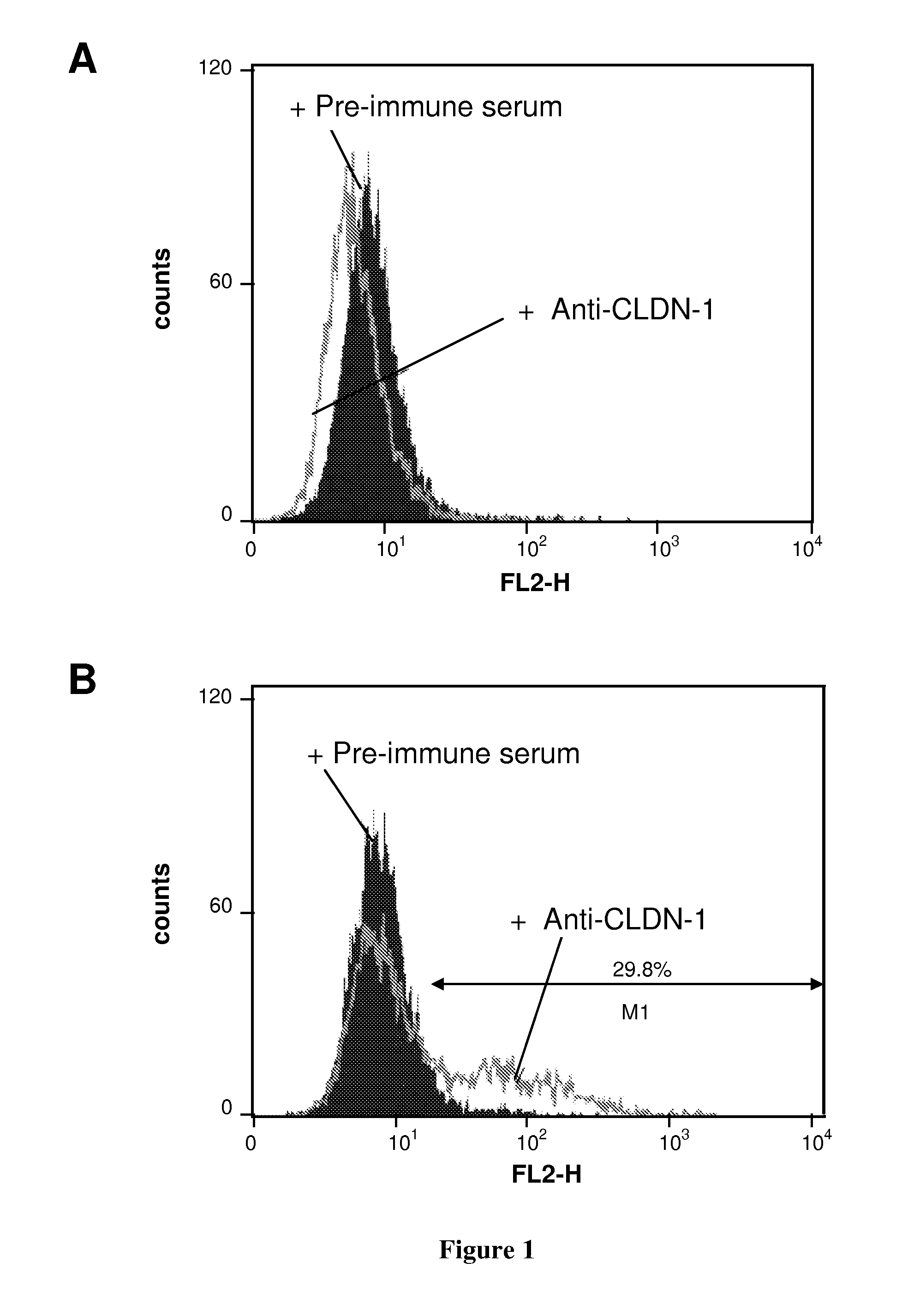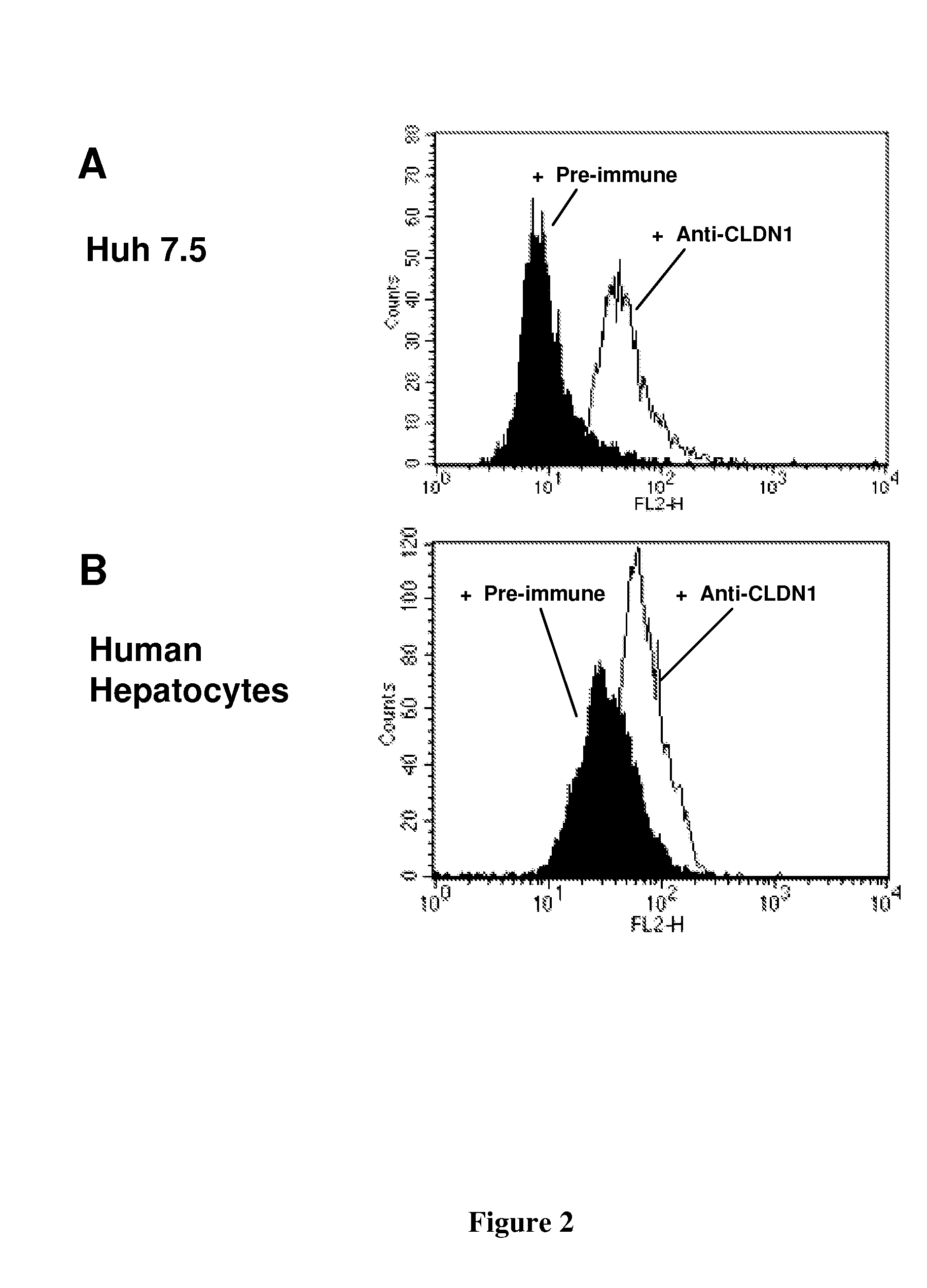Monoclonal anti-claudin 1 antibodies for the inhibition of hepatitis C virus infection
a hepatitis c virus and anti-claudin technology, applied in the direction of antibodies, fused cells, peptide/protein ingredients, etc., can solve the problems of no vaccine against hcv available, graft loss, liver transplantation is not a cure, etc., to prevent hcv infection of the cell, neutralize hcv infectivity, and prevent the effect of hcv infection
- Summary
- Abstract
- Description
- Claims
- Application Information
AI Technical Summary
Benefits of technology
Problems solved by technology
Method used
Image
Examples
example 1
Polyclonal Antibodies Against Human Claudin 1
Materials and Methods
[0149]Cells. Chinese hamster ovary cells (CHO), BOSC23 cells, and Huh7.5.1 hepatoma cells used in the present studies have been described (Barth, 2005; Barth, 2003; Bartosch, 2003; Blight, 2002). BOSC23 cells are HEK293-derived ecotropic packaging cells which do not express endogenous CLDN1 (Pear, 1993). Primary human hepatocytes were isolated and cultured as described by David, 1998 (which is incorporated herein by reference in its entirety).
[0150]Production of Anti-CLDN1 Polyclonal Antibodies. Antibodies directed against the extracellular loop of human Claudin-1 were raised by genetic immunization of Wistar rats using a pcCMVSport 6-expression vector containing the full-length human CLDN-1 cDNA (pcDNA CLDN-1). In brief, animals received five applications of pcDNA CLDN-1, intradermally at 2-week intervals. Pre-immune control serum was collected from the same animal bled before immunization. To analyze the specificity...
example 2
Anti-Claudin-1 Monoclonal Antibodies
Materials and Methods
[0162]Cell Lines and Primary Hepatocytes. Culture of human Huh7 (Steinmann, 2004), Huh7.5.1 (Zhong, 2005), 293T (Pestka, 2007), BOSC23 (Pear, 1993), hamster CHO (Barth, 2005) and murine Hepa1.6 cells (Steinmann, 2004) have been described previously. Primary human and mouse hepatocytes were isolated and cultured as described (Codran, 2006; Lan, 2008; Zeisel, 2007). Primary cynomolgus hepatocytes were purchased from PRIMACYT Cell Culture Technology GmbH, Germany.
[0163]Binding of anti-CLDN1 Mabs to Primary Human Hepatocytes and Cross-Competition Analysis. Huh7.5.1 cells or primary human or cynomolgus hepatocytes (2×105 cells / well) were incubated for 30 minutes at room temperature with increasing concentrations of anti-CLDN1 mAbs in phosphate-buffered saline (PBS)-3% fetal calf serum (FCS). MAb binding was revealed by incubation with PE-conjugated anti-rat IgG mAb (Southern Biotechnology Associates). As a control, isotype-matched ...
example 3
Mechanism of Action of Anti-CLDN1 Monoclonal Antibodies
Materials and Methods
[0202]Cell Lines. As described in Example 2. HEK293T / CLDN1+ cells (clone IIIA6) were obtained by stable transfection of HEK293T cells with a pcDNA3.1 vector encoding CLDN1 cDNA.
[0203]Antibodies. As described in Example 2. In addition, polyclonal rat anti-SR-BI or CD81 antibodies were obtained by genetic immunization as described (Zeisel, 2007). R-phycoerythrin-conjugated goat anti-rat IgG was from Jackson ImmunoResearch Laboratories, mouse IgG from Caltag, mouse anti-CD81 (JS-81) from BD Biosciences.
[0204]Cellular Binding of HCV envelope Glycoproteins and Infectious Virions. Production and binding of C-terminally truncated envelope glycoproteins E1 and E2 to target cells has been described (Haberstroh, 2008; Dreux, 2009). For the study of E2-entry factor interaction, CHO cells were transiently transfected with pcDNA3 based expression vectors encoding SR-BI; CD81 or CLDN1 (Barth, 2005). Expression of entry fa...
PUM
| Property | Measurement | Unit |
|---|---|---|
| concentrations | aaaaa | aaaaa |
| concentrations | aaaaa | aaaaa |
| concentration | aaaaa | aaaaa |
Abstract
Description
Claims
Application Information
 Login to View More
Login to View More - R&D
- Intellectual Property
- Life Sciences
- Materials
- Tech Scout
- Unparalleled Data Quality
- Higher Quality Content
- 60% Fewer Hallucinations
Browse by: Latest US Patents, China's latest patents, Technical Efficacy Thesaurus, Application Domain, Technology Topic, Popular Technical Reports.
© 2025 PatSnap. All rights reserved.Legal|Privacy policy|Modern Slavery Act Transparency Statement|Sitemap|About US| Contact US: help@patsnap.com



